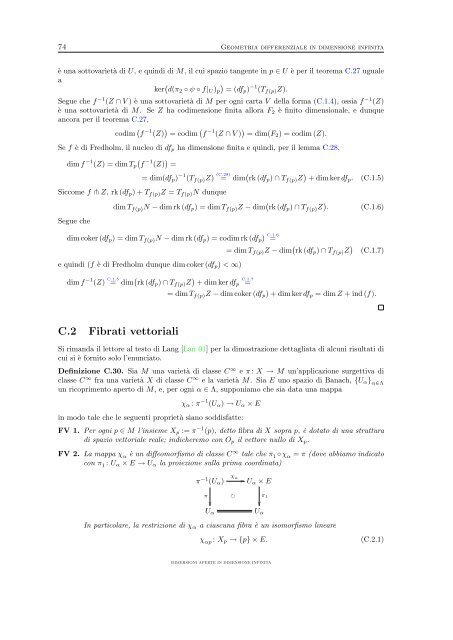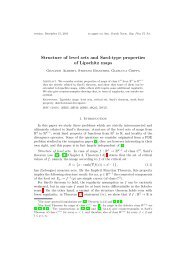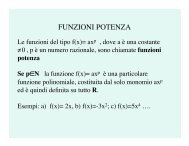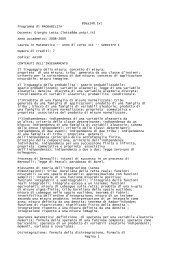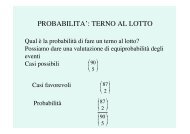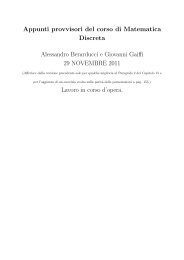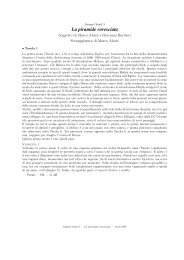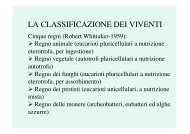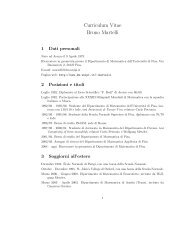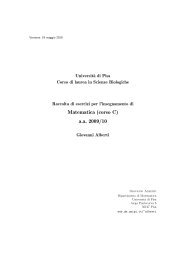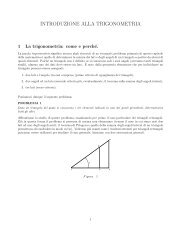Immersioni aperte in dimensione infinita - Dipartimento di Matematica
Immersioni aperte in dimensione infinita - Dipartimento di Matematica
Immersioni aperte in dimensione infinita - Dipartimento di Matematica
You also want an ePaper? Increase the reach of your titles
YUMPU automatically turns print PDFs into web optimized ePapers that Google loves.
74 Geometria <strong>di</strong>fferenziale <strong>in</strong> <strong><strong>di</strong>mensione</strong> <strong>in</strong>f<strong>in</strong>ita<br />
è una sottovarietà <strong>di</strong> U, e qu<strong>in</strong><strong>di</strong> <strong>di</strong> M, il cui spazio tangente <strong>in</strong> p ∈ U è per il teorema C.27 uguale<br />
a<br />
ker <br />
d(π2 ◦ ψ ◦ f|U )p = (dfp) −1 (Tf(p)Z). Segue che f −1 (Z ∩ V ) è una sottovarietà <strong>di</strong> M per ogni carta V della forma (C.1.4), ossia f −1 (Z)<br />
è una sottovarietà <strong>di</strong> M. Se Z ha co<strong><strong>di</strong>mensione</strong> f<strong>in</strong>ita allora F2 è f<strong>in</strong>ito <strong>di</strong>mensionale, e dunque<br />
ancora per il teorema C.27,<br />
co<strong>di</strong>m f −1 (Z) = co<strong>di</strong>m f −1 (Z ∩ V ) = <strong>di</strong>m(F2) = co<strong>di</strong>m (Z).<br />
Se f è <strong>di</strong> Fredholm, il nucleo <strong>di</strong> dfp ha <strong><strong>di</strong>mensione</strong> f<strong>in</strong>ita e qu<strong>in</strong><strong>di</strong>, per il lemma C.28,<br />
<strong>di</strong>m f −1 −1<br />
(Z) = <strong>di</strong>m Tp f (Z) =<br />
= <strong>di</strong>m(dfp) −1 (Tf(p)Z) (C.28)<br />
= <strong>di</strong>m rk (dfp) ∩ Tf(p)Z + <strong>di</strong>m ker dfp. (C.1.5)<br />
Siccome f ⋔ Z, rk (dfp) + T f(p)Z = T f(p)N dunque<br />
Segue che<br />
<strong>di</strong>m T f(p)N − <strong>di</strong>m rk (dfp) = <strong>di</strong>m T f(p)Z − <strong>di</strong>m rk (dfp) ∩ T f(p)Z . (C.1.6)<br />
<strong>di</strong>m coker (dfp) = <strong>di</strong>m Tf(p)N − <strong>di</strong>m rk (dfp) = co<strong>di</strong>m rk (dfp) C.1.6<br />
=<br />
= <strong>di</strong>m Tf(p)Z − <strong>di</strong>m rk (dfp) ∩ Tf(p)Z <br />
e qu<strong>in</strong><strong>di</strong> (f è <strong>di</strong> Fredholm dunque <strong>di</strong>m coker (dfp) < ∞)<br />
(C.1.7)<br />
<strong>di</strong>m f −1 (Z) C.1.5<br />
= <strong>di</strong>m rk (dfp) ∩ Tf(p)Z C.1.7<br />
+ <strong>di</strong>m ker dfp =<br />
= <strong>di</strong>m Tf(p)Z − <strong>di</strong>m coker (dfp) + <strong>di</strong>m ker dfp = <strong>di</strong>m Z + <strong>in</strong>d (f).<br />
C.2 Fibrati vettoriali<br />
Si rimanda il lettore al testo <strong>di</strong> Lang [Lan 01] per la <strong>di</strong>mostrazione dettagliata <strong>di</strong> alcuni risultati <strong>di</strong><br />
cui si è fornito solo l’enunciato.<br />
Def<strong>in</strong>izione C.30. Sia M una varietà <strong>di</strong> classe C ∞ e π : X → M un’applicazione surgettiva <strong>di</strong><br />
classe C ∞ fra una varietà X <strong>di</strong> classe C ∞ e la varietà M. Sia E uno spazio <strong>di</strong> Banach, {Uα} α∈Λ<br />
un ricoprimento aperto <strong>di</strong> M, e, per ogni α ∈ Λ, supponiamo che sia data una mappa<br />
χα : π −1 (Uα) → Uα × E<br />
<strong>in</strong> modo tale che le seguenti proprietà siano sod<strong>di</strong>sfatte:<br />
FV 1. Per ogni p ∈ M l’<strong>in</strong>sieme Xp := π −1 (p), detto fibra <strong>di</strong> X sopra p, è dotato <strong>di</strong> una struttura<br />
<strong>di</strong> spazio vettoriale reale; <strong>in</strong><strong>di</strong>cheremo con Op il vettore nullo <strong>di</strong> Xp.<br />
FV 2. La mappa χ α è un <strong>di</strong>ffeomorfismo <strong>di</strong> classe C ∞ tale che π 1 ◦χ α = π (dove abbiamo <strong>in</strong><strong>di</strong>cato<br />
con π 1 : Uα × E → Uα la proiezione sulla prima coord<strong>in</strong>ata)<br />
π −1 (Uα)<br />
π <br />
<br />
Uα<br />
χα <br />
Uα × E<br />
In particolare, la restrizione <strong>di</strong> χα a ciascuna fibra è un isomorfismo l<strong>in</strong>eare<br />
<br />
Uα<br />
π1<br />
χ αp : Xp → {p} × E. (C.2.1)<br />
IMMERSIONI APERTE IN DIMENSIONE INFINITA


